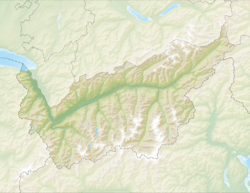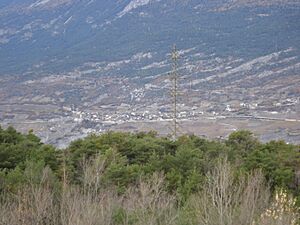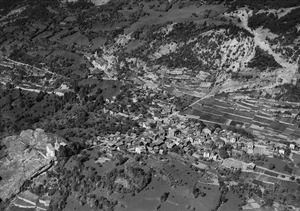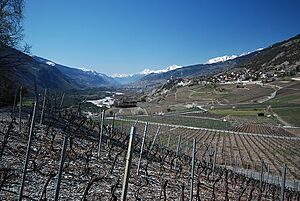Varen, Switzerland facts for kids
Quick facts for kids
Varen
|
||
|---|---|---|

Varen village
|
||
|
||
| Country | Switzerland | |
| Canton | Valais | |
| District | Leuk | |
| Area | ||
| • Total | 12.81 km2 (4.95 sq mi) | |
| Elevation | 716 m (2,349 ft) | |
| Population
(Dec 2020 )
|
||
| • Total | 682 | |
| • Density | 53.24/km2 (137.89/sq mi) | |
| Postal code |
3953
|
|
| Surrounded by | Inden, Leuk, Mollens, Salgesch | |
Varen (also known as Varone in French) is a small town in Switzerland. It's located in the Valais canton, which is like a state, and is part of the Leuk district.
Contents
History of Varen
Varen was first mentioned in official records way back in 1225. Its name then was Varonam.
Interestingly, Varen was also used as a filming location for a British/American TV show. It was a crime drama called "The Missing."
Geography of Varen
Varen covers an area of about 12.8 square kilometers (about 4.9 square miles). This is how the land is used:
- About 31.7% is used for farming.
- About 34.0% is covered by forests.
- About 4.0% has buildings or roads.
- About 1.3% is rivers or lakes.
- About 28.6% is land that can't be used for farming or building.
Most of the built-up area is for homes and other buildings (1.4%). Roads and other transport areas make up 2.0%. In the forested areas, 30.2% is dense forest. Another 3.7% has orchards or small groups of trees.
For farming, 0.1% is used for growing crops. About 1.6% is pastures for animals. A larger part, 9.3%, is used for orchards or vineyards. Another 20.7% is used for mountain pastures. All the water in Varen is from flowing rivers or streams.
The land that isn't used for farming or building has some interesting features. About 9.8% is unproductive plants. A big part, 18.9%, is too rocky for plants to grow. Varen is located in the Leuk district. It sits on the right side of the Rhone river, above the Pfynwald (Pfyn woods).
Varen's Coat of Arms
The coat of arms for Varen has a special design. It shows a green tree with roots on a gold background. Below the tree are green hills. Above the tree, on a blue background, there are three white five-pointed stars.
Population and People in Varen
Varen has a population of 682 people. In 2008, about 5.8% of the people living in Varen were from other countries. Over ten years (from 1999 to 2009), the population slightly decreased by 7.3%. This change was due to more people moving away than moving in, and more deaths than births.
Most people in Varen speak German as their main language (94.0%). The second most common language is Serbo-Croatian (3.3%). A smaller number of people speak French (1.3%) or Italian.
In 2008, about 48.9% of the population were male and 51.1% were female. Most people in Varen (about 63.0%) were born there. Another 22.1% were born in the same canton (Valais). About 6.8% were born elsewhere in Switzerland, and 6.8% were born outside Switzerland.
Looking at age groups in 2000:
- Children and teenagers (0–19 years old) made up 19.9% of the population.
- Adults (20–64 years old) made up 64%.
- Seniors (over 64 years old) made up 16.1%.
In 2000, there were 254 homes in Varen. On average, about 2.3 people lived in each home. About 27.7% of homes had only one person living there. There were also 11 homes with five or more people.
The chart below shows how Varen's population has changed over many years:

Economy and Jobs in Varen
In 2010, the unemployment rate in Varen was very low, at 0.9%. This means almost everyone who wanted a job had one.
In 2008, there were 120 people working in the primary sector. This sector mainly includes farming, fishing, and mining. Varen had 58 businesses in this area.
The secondary sector had 16 workers and 7 businesses. This sector includes manufacturing (making things) and construction (building things).
The tertiary sector had 57 workers and 17 businesses. This sector is about services, like shops, hotels, and healthcare.
In 2008, there were 116 full-time jobs in Varen. Most of these (60 jobs) were in agriculture. In the secondary sector, 6 jobs were in manufacturing and 5 were in construction. In the service sector, 15 jobs were in sales or car repair. Six jobs were in transport and storage. Another 6 jobs were in hotels or restaurants. There were also jobs in finance, science, education, and healthcare.
Many people who live in Varen travel to other towns for work. In 2000, 201 people left Varen to work elsewhere, while only 20 people came into Varen for work. This means Varen is a "net exporter" of workers. About 19.1% of workers used public transport, and 55.9% used a private car to get to work.
Religion in Varen
According to the 2000 census, most people in Varen are Roman Catholic (90.4%). A smaller group (3.8%) belonged to the Swiss Reformed Church. About 3.65% were members of an Orthodox church. A very small number (0.33%) were Islamic. About 1.16% of the population did not belong to any church.
Education in Varen
In Varen, about 31.7% of people have finished upper secondary education. This is like high school. About 4.7% have gone on to higher education, like a university or a specialized college.
In the 2010-2011 school year, Varen had 43 students in its school system. In the Canton of Valais, young children can go to kindergarten for one year. Varen had one kindergarten class with 12 students.
The canton's school system requires six years of primary school. Varen had 3 primary school classes with 43 students. After primary school, students attend secondary school. The first three years are required, and then students can choose to continue for three to five more years. All secondary students from Varen go to school in a nearby town.
In 2000, only one student came to Varen from another town for school. However, 30 students from Varen went to schools outside the town.
See also
 In Spanish: Varen (Valais) para niños
In Spanish: Varen (Valais) para niños







